Deadwood Amount at Disturbance Plots after Sanitary Felling
Abstract
:1. Introduction
2. Results
2.1. State and Amount of Deadwood at Disturbed Areas
2.2. Deadwood Coverage
2.3. Impact of Site Characteristics on Deadwood Amount and Coverage
2.4. Models of Deadwood Volume
2.5. Accuracy and Precision of Deadwood Quantification Using a Photogrammetric Method
3. Discussion
4. Materials and Methods
5. Conclusions
Author Contributions
Funding
Institutional Review Board Statement
Informed Consent Statement
Data Availability Statement
Acknowledgments
Conflicts of Interest
References
- Esseen, P.-A.; Ehnström, B.; Ericson, L.; Sjöberg, K. Boreal Forests—The Focal Habitats of Fennoscandia. In Ecological Principles of Nature Conservation: Application in Temperate and Boreal Environments; Hansson, L., Ed.; Conservation Ecology Series: Principles, Practices and Management; Springer US: Boston, MA, USA, 1992; pp. 252–325. ISBN 978-1-4615-3524-9. [Google Scholar]
- Harmon, M.E.; Franklin, J.F.; Swanson, F.J.; Sollins, P.; Gregory, S.V.; Lattin, J.D.; Anderson, N.H.; Cline, S.P.; Aumen, N.G.; Sedell, J.R.; et al. Ecology of Coarse Woody Debris in Temperate Ecosystems. In Advances in Ecological Research; MacFadyen, A., Ford, E.D., Eds.; Academic Press: Cambridge, MA, USA, 1986; Volume 15, pp. 133–302. ISBN 0065-2504. [Google Scholar]
- Ohlson, M.; Söderström, L.; Hörnberg, G.; Zackrisson, O.; Hermansson, J. Habitat qualities versus long-term continuity as determinants of biodiversity in boreal old-growth swamp forests. Biol. Conserv. 1997, 81, 221–231. [Google Scholar] [CrossRef]
- Esseen, P.-A.; Ehnström, B.; Ericson, L.; Sjöberg, K. Boreal forests. Ecol. Bull. 1997, 46, 16–47. [Google Scholar]
- Ferris-Kaan, R.; Lonsdale, D.; Winter, T. The conservation management of deadwood in forests. Res. Inf. Note-For. Auth. Res. Div. 1993, 241, 8. [Google Scholar]
- Maser, C.; Trappe, J. The seen and unseen world of the fallen tree. In Gen. Tech. Rep. PNW-GTR-164; Department of Agriculture, Forest Service, Pacific Northwest Forest and Range Experiment Station: Portland, OR, USA, 1984. [Google Scholar]
- Samuelsson, J.; Gustafsson, L.; Ingelög, T. Dying and dead trees. A review of their importance for biodiversity. Rapport-Naturvaardsverket 1994, 4306, 87–104. [Google Scholar]
- Siitonen, J. Forest Management, Coarse Woody Debris and Saproxylic Organisms: Fennoscandian Boreal Forests as an Example. Ecol. Bull. 2001, 49, 11–41. [Google Scholar]
- EEA. European Forest Types. Categories and Types for Sustainable Forest Management Reporting and Policy; EEA: Copenhagen, Denmark, 2007; p. 111.
- Keenan, R.J.; Prescott, C.E.; Kimmins, J.H. Mass and nutrient content of woody debris and forest floor in western red cedar and western hemlock forests on northern Vancouver Island. Can. J. For. Res. 1993, 23, 1052–1059. [Google Scholar] [CrossRef]
- Pasinelli, K.; Suter, W. Lebensraum Totholz. Merkbl. Prax. 2002, 33, 6. [Google Scholar]
- Wambsganss, J.; Stutz, K.P.; Lang, F. European beech deadwood can increase soil organic carbon sequestration in forest topsoils. For. Ecol. Manag. 2017, 405, 200–209. [Google Scholar] [CrossRef]
- Zell, J.; Kändler, G.; Hanewinkel, M. Predicting constant decay rates of coarse woody debris—a meta-analysis approach with a mixed model. Ecol. Modell. 2009, 220, 904–912. [Google Scholar] [CrossRef]
- Eichrodt, R. Über die Bedeutung von Moderholz für die Natürliche Verjüngung im Subalpinen Fichtenwald. Doctoral Dissertation, ETH Zurich, Zurich, Germany, 1969. [Google Scholar]
- Hofgaard, A. Structure and regeneration patterns in a virgin Picea abies forest in northern Sweden. J. Veg. Sci. 1993, 4, 601–608. [Google Scholar] [CrossRef]
- Konôpka, B.; Šebeň, V.; Merganičová, K. Forest Regeneration Patterns Differ Considerably between Sites with and without Windthrow Wood Logging in the High Tatra Mountains. Forests 2021, 12, 1349. [Google Scholar] [CrossRef]
- Merganič, J.; Vorčák, J.; Merganičová, K.; Ďurský, J.; Miková, A.; Škvarenina, J.; Tuček, J.; Minďáš, J. Diversity Monitoring in Mountain Forests of Eastern Orava; EFRA Zvolen: Tvrdošín, Slovakia, 2003; p. 200. [Google Scholar]
- Takahashi, M.; Sakai, Y.; Ootomo, R.; Shiozaki, M. Establishment of tree seedlings and water-soluble nutrients in coarse woody debris in an old-growth Picea-Abies forest in Hokkaido, northern Japan. Can. J. For. Res. 2000, 30, 1148–1155. [Google Scholar] [CrossRef]
- Vorčák, J.; Merganič, J.; Saniga, M. Structural diversity change and regeneration processes of the Norway spruce natural forest in Babia hora NNR in relation to altitude. J. For. Sci. 2012, 52, 399–409. [Google Scholar] [CrossRef] [Green Version]
- Vorčák, J.; Merganič, J.; Merganičová, K. Deadwood and spruce regeneration. Lesn. Pr. 2005, 5, 18–19. [Google Scholar]
- Vorčák, J.; Merganič, J.; Merganičova, K. Regeneration processes of natural spruce forest in the the subalpine forest belt of National Nature Reserve of Babia hora, Beskydy. In Babia Góra Nasze Wspólne Dziedzictwo; Babiogórski Park Narodowy: Zawoja, Poland, 2005; pp. 81–94. [Google Scholar]
- Hartanto, H.; Prabhu, R.; Widayat, A.S.E.; Asdak, C. Factors affecting runoff and soil erosion: Plot-level soil loss monitoring for assessing sustainability of forest management. For. Ecol. Manag. 2003, 180, 361–374. [Google Scholar] [CrossRef]
- Hewlett, J.D. Principles of Forest Hydrology; University of Georgia Press: Athens, GA, USA, 1982; ISBN 978-0-8203-2380-0. [Google Scholar]
- Kupferschmid Albisetti, A.D.; Brang, P.; Schönenberger, W.; Bugmann, H. Decay of Picea abies snag stands on steep mountain slopes. For. Chron. 2003, 79, 247–252. [Google Scholar] [CrossRef]
- Humphrey, J.W.; Sippola, A.L.; Lempérière, G.; Dodelin, B.; Alexander, K.N.A.; Butler, J.E. Deadwood as an indicator of biodiversity in European forests: From theory to operational guidance. Monit. Indic. For. Biodiv. Eur. Ideas Oper. 2005, 51, 193–206. [Google Scholar]
- Bujoczek, L.; Bujoczek, M.; Zięba, S. How much, why and where? Deadwood in forest ecosystems: The case of Poland. Ecol. Indic. 2021, 121, 107027. [Google Scholar] [CrossRef]
- Green, P.; Peterken, G. Variation in the amount of dead wood in the woodlands of the Lower Wye Valley, UK in relation to the intensity of management. For. Ecol. Manag. 1997, 98, 229–238. [Google Scholar] [CrossRef]
- Kirby, K.; Reid, C.; Thomas, R.; Goldsmith, F. Preliminary estimates of fallen dead wood and standing dead trees in managed and unmanaged forests in Britain. J. Appl. Ecol. 1998, 35, 148–155. [Google Scholar] [CrossRef]
- Öder, V.; Petritan, A.M.; Schellenberg, J.; Bergmeier, E.; Walentowski, H. Patterns and drivers of deadwood quantity and variation in mid-latitude deciduous forests. For. Ecol. Manag. 2021, 487, 118977. [Google Scholar] [CrossRef]
- Ódor, P.; Standovár, T. Richness of bryophyte vegetation in near-natural and managed beech stands: The effects of management-induced differences in dead wood. Ecol. Bull. 2001, 49, 219–229. [Google Scholar]
- Winter, S.; Nowak, E. Totholz in bewirtschafteten und nicht bewirtschafteten Buchen-und Eichen-Hainbuchenwäldern im Biosphärenreservat Spreewald. Nat.-Landsch. Brandenbg. 2001, 10, 128–133. [Google Scholar]
- Konôpka, J.; Konôpka, B.; Nikolov, C. Snehové polomy v lesných porastoch na Slovensku. Analýza kalamity zo zimy 2005/2006. Lesn. Štúd. 2008, 59, 65. [Google Scholar]
- Seidl, R.; Schelhaas, M.-J.; Rammer, W.; Verkerk, P.J. Increasing forest disturbances in Europe and their impact on carbon storage. Nat. Clim. Chang. 2014, 4, 806–810. [Google Scholar] [CrossRef] [Green Version]
- Stadelmann, G.; Bugmann, H.; Meier, F.; Wermelinger, B.; Bigler, C. Effects of salvage logging and sanitation felling on bark beetle (Ips typographus L.) infestations. For. Ecol. Manag. 2013, 305, 273–281. [Google Scholar] [CrossRef]
- Eräjää, S.; Halme, P.; Kotiaho, J.; Markkanen, A.; Toivanen, T. The volume and composition of dead wood on traditional and forest fuel harvested clear-cuts. Silva Fenn. 2010, 44, 150. [Google Scholar] [CrossRef] [Green Version]
- Juutilainen, K.; Mönkkönen, M.; Kotiranta, H.; Halme, P. The effects of forest management on wood-inhabiting fungi occupying dead wood of different diameter fractions. For. Ecol. Manag. 2014, 313, 283–291. [Google Scholar] [CrossRef]
- Juutilainen, K.; Halme, P.; Kotiranta, H.; Mönkkönen, M. Size matters in studies of dead wood and wood-inhabiting fungi. Fungal Ecol. 2011, 4, 342–349. [Google Scholar] [CrossRef]
- Travaglini, D.; Barbati, A.; Chirici, G.; Lombardi, F.; Marchetti, M.; Corona, P. ForestBIOTA data on deadwood monitoring in Europe. Plant Biosyst.—An Int. J. Deal. Asp. Plant Biol. 2007, 141, 222–230. [Google Scholar] [CrossRef] [Green Version]
- Forest Europe. State of Europe’s Forests 2015; Forest Europe, Liaison Unit Madrid: Madrid, Spain, 2015. [Google Scholar]
- Lassauce, A.; Paillet, Y.; Jactel, H.; Bouget, C. Deadwood as a surrogate for forest biodiversity: Meta-analysis of correlations between deadwood volume and species richness of saproxylic organisms. Ecol. Indic. 2011, 11, 1027–1039. [Google Scholar] [CrossRef]
- Mueller, J.; Bussler, H. Key factors and critical thresholds at stand scale for saproxylic beetles in a beech dominated forest, southern Germany. Rev. d’Écol. 2008, 10, 81–90. [Google Scholar]
- Müller, J.; Bütler, R. A review of habitat thresholds for dead wood: A baseline for management recommendations in European forests. Eur. J. For. Res. 2010, 129, 981–992. [Google Scholar] [CrossRef]
- Angelstam, P.; Breuss, M.; Gossow, H. Visions and tools for biodiversity restoration in coniferous forest. In Forest Ecosystem Restoration: Ecological and Economical Impacts of Restoration Processes in Secondary Coniferous Forests, Proceedings of the International Conference, Vienna, Austria, 10–12 April 2000; Institute of Forest Growth Research: Wien, Austria, 2015; pp. 19–28. [Google Scholar]
- Vandekerkhove, K.; De Keersmaeker, L.; Menke, N.; Meyer, P.; Verschelde, P. When nature takes over from man: Dead wood accumulation in previously managed oak and beech woodlands in North-western and Central Europe. For. Ecol. Manag. 2009, 258, 425–435. [Google Scholar] [CrossRef]
- Albrecht, L. Die Bedeutung des toten Holzes im Wald. Forstw. Cbl. 1991, 110, 106–113. [Google Scholar] [CrossRef]
- Christensen, M.; Hahn, K.; Mountford, E.P.; Ódor, P.; Standovár, T.; Rozenbergar, D.; Diaci, J.; Wijdeven, S.; Meyer, P.; Winter, S.; et al. Dead wood in European beech (Fagus sylvatica) forest reserves. For. Ecol. Manag. 2005, 210, 267–282. [Google Scholar] [CrossRef]
- Karjalainen, L.; Kuuluvainen, T. Amount and diversity of coarse woody debris within a boreal forest landscape dominated by Pinus sylvestris in Vienansalo wilderness, eastern Fennoscandia. Silva Fenn. 2002, 36, 147–167. [Google Scholar] [CrossRef] [Green Version]
- Siitonen, J.; Martikainen, P.; Punttila, P.; Rauh, J. Coarse woody debris and stand characteristics in mature managed and old-growth boreal mesic forests in southern Finland. For. Ecol. Manag. 2000, 128, 211–225. [Google Scholar] [CrossRef]
- Vallauri, D.; Andre, J.; Blondel, J. Dead wood, a typical shortcoming of managed forests. Rev. For. Fr. 2003, 55, 99–112. [Google Scholar]
- Puletti, N.; Giannetti, F.; Chirici, G.; Canullo, R. Deadwood distribution in European forests. J. Maps 2017, 13, 733–736. [Google Scholar] [CrossRef]
- Saniga, M.; Schütz, J.P. Relation of dead wood course within the development cycle of selected virgin forests in Slovakia. J. For. Sci. 2002, 48, 513–528. [Google Scholar] [CrossRef]
- Bobiec, A. Living stands and dead wood in the Białowieża forest: Suggestions for restoration management. For. Ecol. Manag. 2002, 165, 125–140. [Google Scholar] [CrossRef]
- Debeljak, M. Coarse woody debris in virgin and managed forest. Ecol. Indic. 2006, 6, 733–742. [Google Scholar] [CrossRef]
- Merganič, J.; Šebeň, V.; Merganičová, K. Zásoba odumretého dreva v 1. až 4. vegetačnom stupni a v azonálnych spoločenstvách. In Štruktúra a Diverzita Lesných Ekosystémov na Slovensku; Vladovič, J., Ed.; Národné Lesnícke Centrum—Lesnícky Výskumný Ústav: Zvolen, Slovakia, 2011; pp. 207–217. ISBN 978-80-8093-153-7. [Google Scholar]
- Bruijnzeel, L.A.S. Hydrology of Moist Tropical Forests and Effects of Conversion: A State of Knowledge Review; Unesco International Hydrological Programme: Paris, France, 1990. [Google Scholar]
- Bruijnzeel, L.A. Hydrological functions of tropical forests: Not seeing the soil for the trees? Agric. Ecosyst. Environ. 2004, 104, 185–228. [Google Scholar] [CrossRef]
- Trimble, S.W.; Mendel, A.C. The cow as a geomorphic agent—A critical review. Geomorphology 1995, 13, 233–253. [Google Scholar] [CrossRef]
- Elliot, W.; Page-Dumroese, D.; Robichaud, P. The Effects of Forest Management on Erosion and Soil Productivity. In Soil Quality and Soil Erosion; Routledge: London, UK, 2018; pp. 195–208. ISBN 978-0-203-73926-6. [Google Scholar]
- Pinno, B.D.; Das Gupta, S. Coarse Woody Debris as a Land Reclamation Amendment at an Oil Sands Mining Operation in Boreal Alberta, Canada. Sustainability 2018, 10, 1640. [Google Scholar] [CrossRef] [Green Version]
- Tinker, D.B.; Knight, D.H. Temporal and spatial dynamics of coarse woody debris in harvested and unharvested lodgepole pine forests. Ecol. Modell. 2001, 141, 125–149. [Google Scholar] [CrossRef]
- Carey, A.B.; Johnson, M.L. Small Mammals in Managed, Naturally Young, and Old-Growth Forests. Ecol. Appl. 1995, 5, 336–352. [Google Scholar] [CrossRef]
- Ucitel, D.; Christian, D.P.; Graham, J.M. Vole Use of Coarse Woody Debris and Implications for Habitat and Fuel Management. J. Wildl. Manag. 2003, 67, 65–72. [Google Scholar] [CrossRef]
- Brown, J.K.; Reinhardt, E.D.; Kramer, K.A. Coarse Woody Debris: Managing Benefits and Fire Hazard in the Recovering Forest; U.S. Department of Agriculture, Forest Service, Rocky Mountain Research Station: Ft. Collins, CO, USA, 2003; p. RMRS-GTR-105. [Google Scholar]
- Bütler, R.; Schlaepfer, R. Wie viel Totholz braucht der Wald? | Dead wood in managed forests: How much is enough? Schweiz. Z. Forstwes. 2004, 155, 31–37. [Google Scholar] [CrossRef]
- Bütler Sauvain, R. Dead Wood in Managed Forests: How Much and How Much is Enough?: Development of a Snag-Quantification Method by Remote Sensing & GIS and Snag Targets Based on Three-toed Woodpeckers’ Habitat Requirements; EPFL: Lausanne, Switzerland, 2003. [Google Scholar]
- Maltamo, M.; Kallio, E.; Bollandsås, O.M.; Næsset, E.; Gobakken, T.; Pesonen, A. Assessing Dead Wood by Airborne Laser Scanning. In Forestry Applications of Airborne Laser Scanning: Concepts and Case Studies; Maltamo, M., Næsset, E., Vauhkonen, J., Eds.; Managing Forest Ecosystems; Springer: Dordrecht, The Netherlands, 2014; pp. 375–395. ISBN 978-94-017-8663-8. [Google Scholar]
- Pesonen, A.; Maltamo, M.; Eerikäinen, K.; Packalèn, P. Airborne laser scanning-based prediction of coarse woody debris volumes in a conservation area. For. Ecol. Manag. 2008, 255, 3288–3296. [Google Scholar] [CrossRef]
- Vehmas, M.; Packalén, P.; Maltamo, M. Assessing deadwood existence in canopy gaps by using ALS data. In Proceedings of the Silvilaser, College Station, TX, USA, 14–16 October 2009. [Google Scholar]
- Marchi, N.; Pirotti, F.; Lingua, E. Airborne and Terrestrial Laser Scanning Data for the Assessment of Standing and Lying Deadwood: Current Situation and New Perspectives. Remote Sens. 2018, 10, 1356. [Google Scholar] [CrossRef] [Green Version]
- Krisanski, S.; Taskhiri, M.S.; Gonzalez Aracil, S.; Herries, D.; Turner, P. Sensor Agnostic Semantic Segmentation of Structurally Diverse and Complex Forest Point Clouds Using Deep Learning. Remote Sens. 2021, 13, 1413. [Google Scholar] [CrossRef]
- Mokroš, M.; Výbošťok, J.; Merganič, J.; Hollaus, M.; Barton, I.; Koreň, M.; Tomaštík, J.; Čerňava, J. Early Stage Forest Windthrow Estimation Based on Unmanned Aircraft System Imagery. Forests 2017, 8, 306. [Google Scholar] [CrossRef] [Green Version]
- Tomaštík, J.; Mokroš, M.; Surový, P.; Grznárová, A.; Merganič, J. UAV RTK/PPK Method—An Optimal Solution for Mapping Inaccessible Forested Areas? Remote Sens. 2019, 11, 721. [Google Scholar] [CrossRef] [Green Version]
- Šmelko, Š. Dendrometria; Vydavateľstvo TU Zvolen: Zvolen, Slovakia, 2007. [Google Scholar]
- West, P.W. Tree and Forest Measurement, 3rd ed.; Springer International Publishing: Cham, Switzerland, 2015; ISBN 978-3-319-14707-9. [Google Scholar]
- R Core Team. R: A Language and Environment for Statistical Computing; Foundation for Statistical Computing: Vienna, Austria, 2019. [Google Scholar]
- Wickham, H. ggplot2: Elegant Graphics for Data Analysis; Springer: New York, NY, USA, 2016; ISBN 978-3-319-24277-4. [Google Scholar]
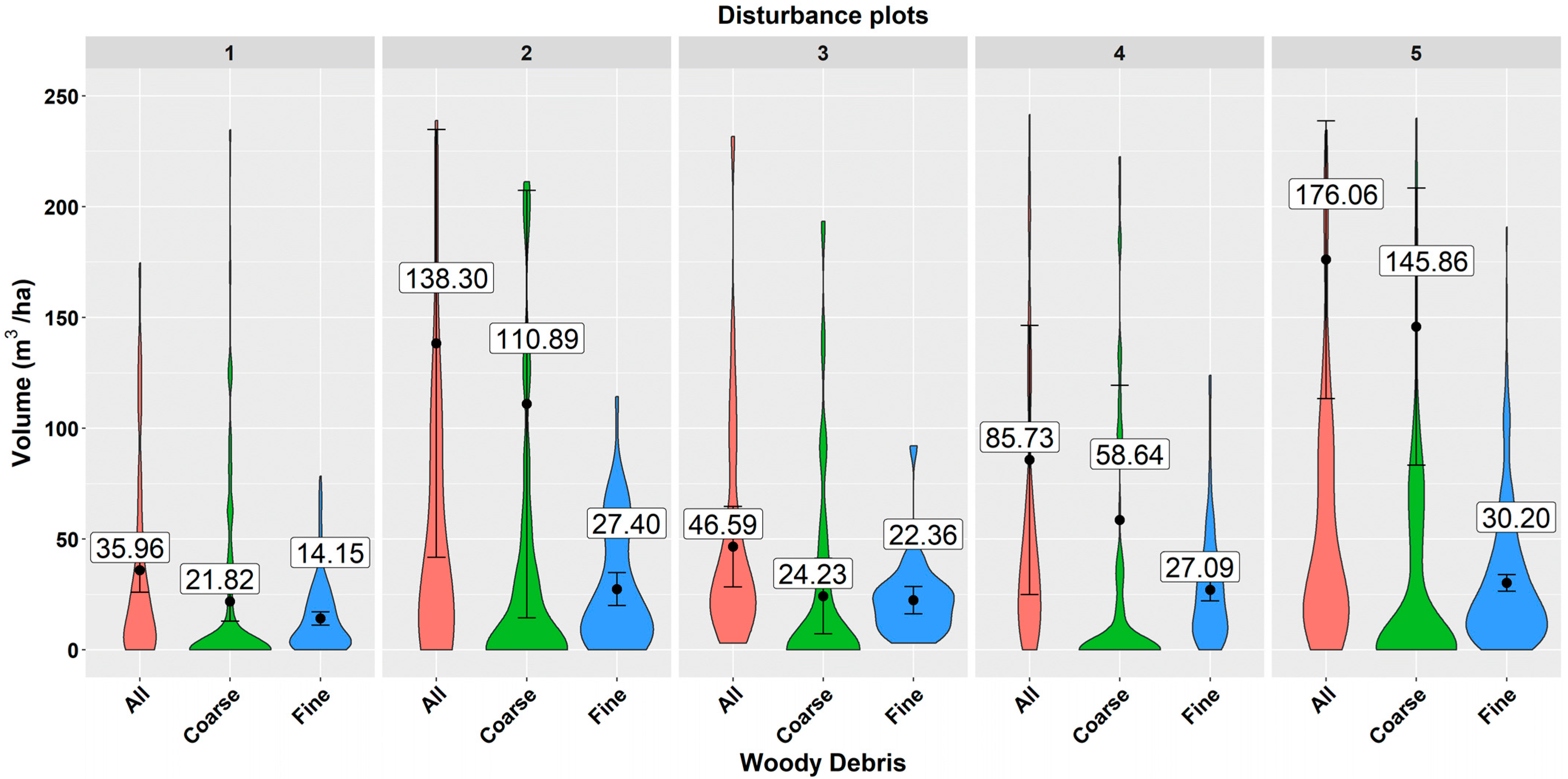
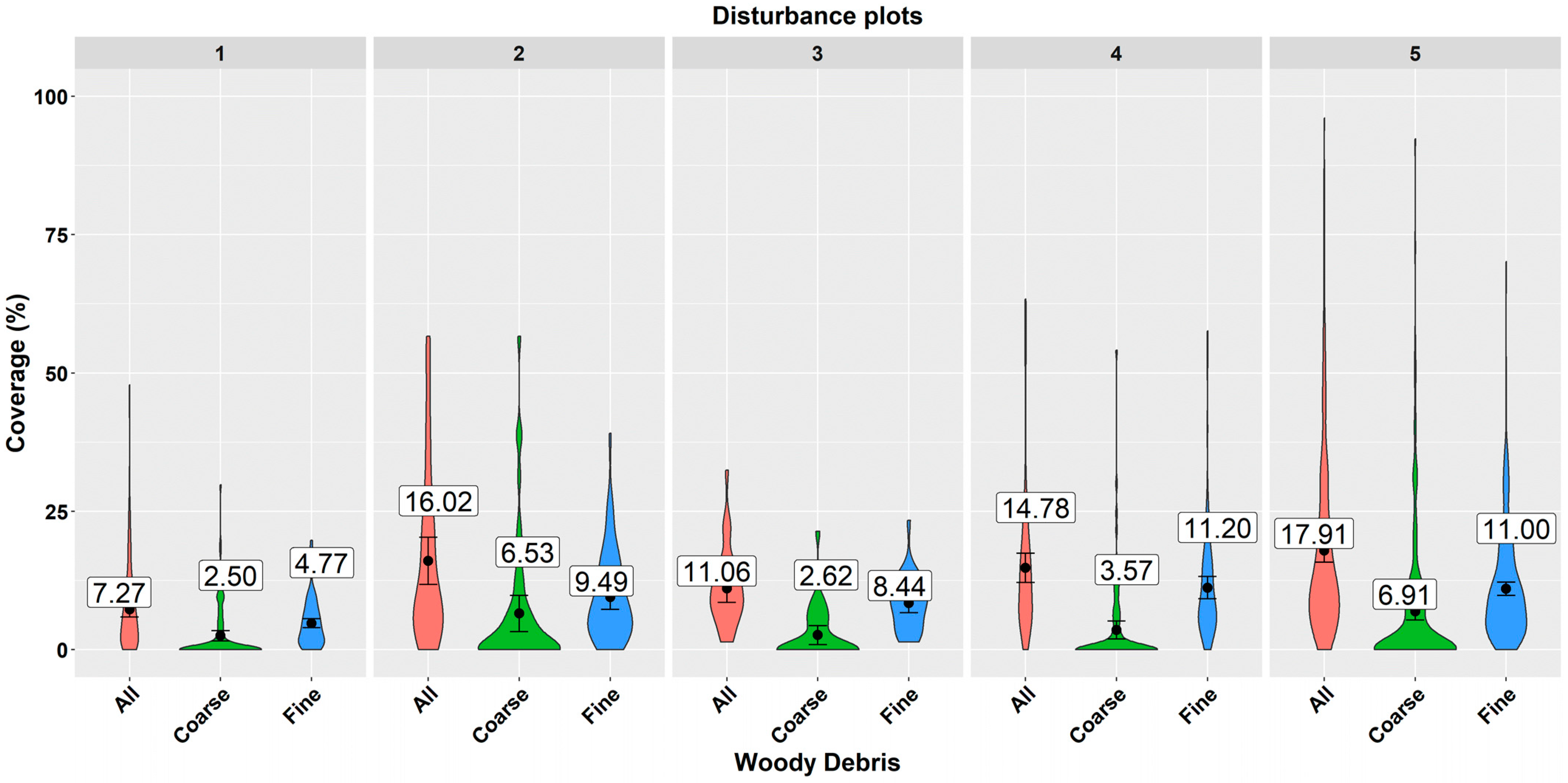
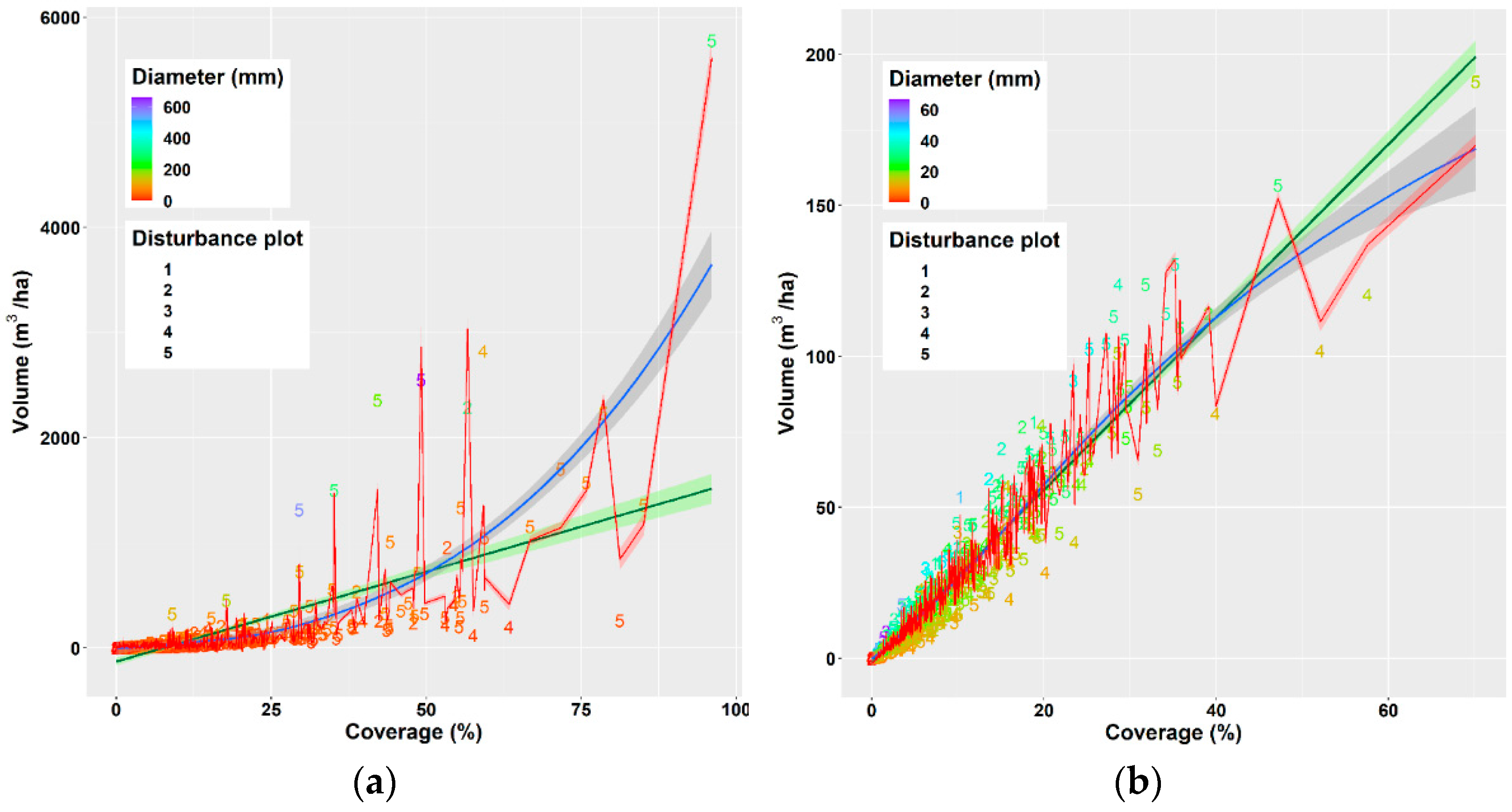
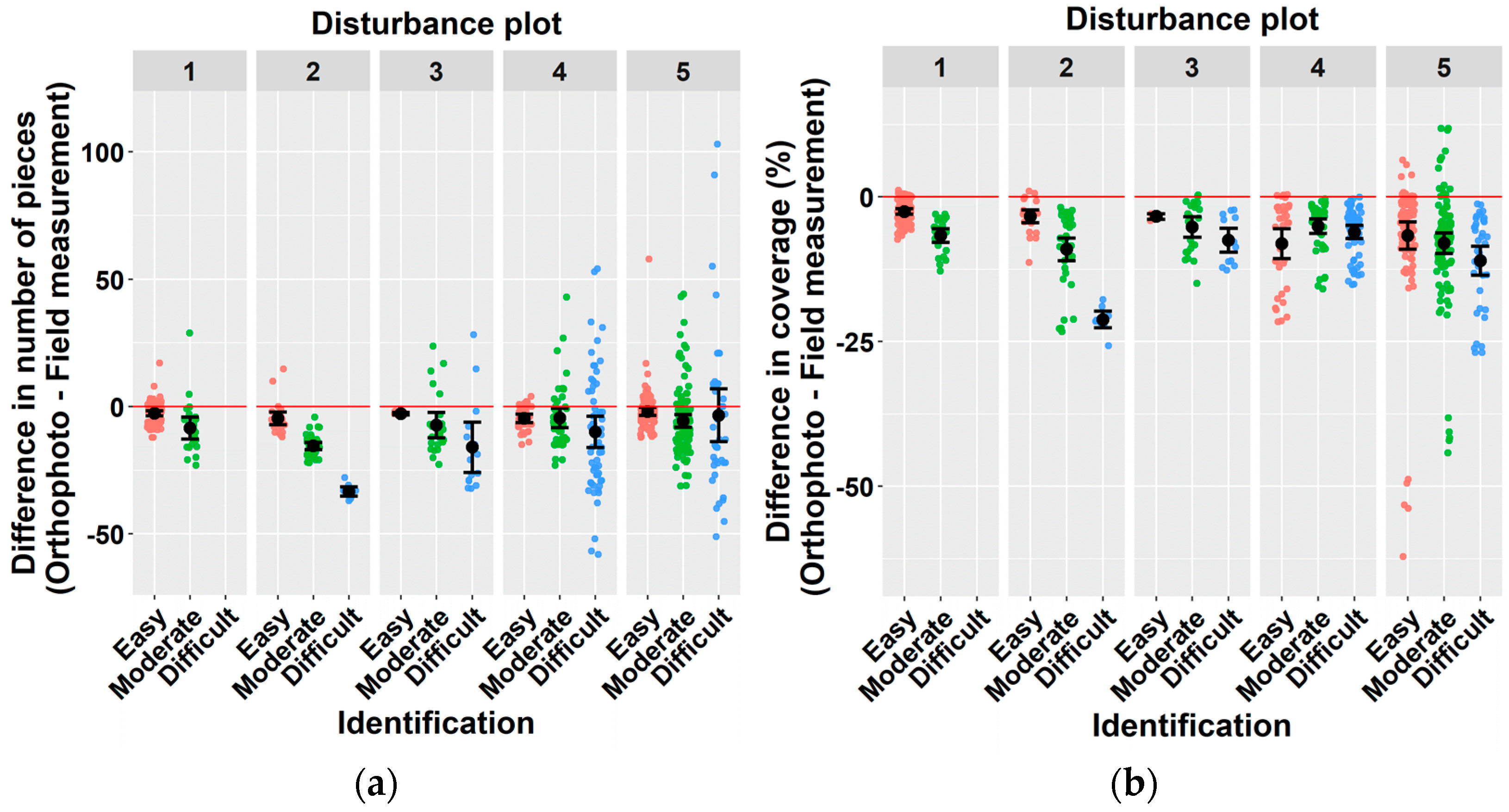
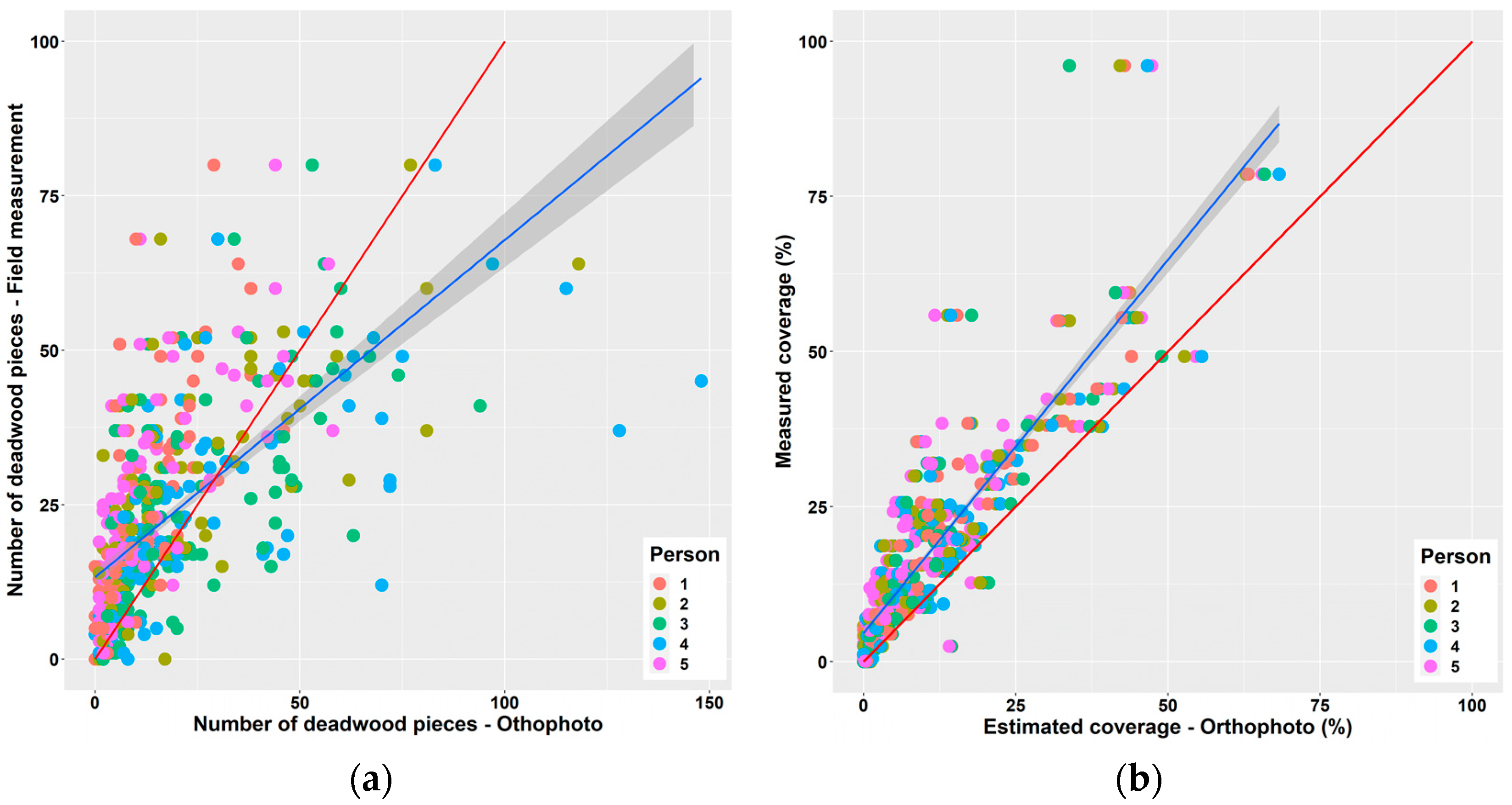


| Area | Deadwood | n | Total Volume | SD | SE | 95 %IS | 95 %DI | 95 %HI | Proportion |
|---|---|---|---|---|---|---|---|---|---|
| (m3) | |||||||||
| 1 | All | 110 | 190.1 | 277.7 | 26.5 | 52.5 | 137.6 | 242.6 | 100.0 |
| Coarse | 110 | 115.3 | 246.7 | 23.5 | 46.6 | 68.7 | 161.9 | 60.7 | |
| Fine | 110 | 74.8 | 83.2 | 7.9 | 15.7 | 59 | 90.5 | 39.3 | |
| 2 | All | 52 | 337.8 | 846.6 | 117.4 | 235.7 | 102.1 | 573.5 | 100.0 |
| Coarse | 52 | 270.9 | 846.1 | 117.3 | 235.6 | 35.3 | 506.4 | 80.2 | |
| Fine | 52 | 66.9 | 65.6 | 9.1 | 18.3 | 48.7 | 85.2 | 19.8 | |
| 3 | All | 31 | 35 | 37.2 | 6.7 | 13.6 | 21.3 | 48.6 | 100.0 |
| Coarse | 31 | 18.2 | 34.8 | 6.3 | 12.8 | 5.4 | 30.9 | 52.0 | |
| Fine | 31 | 16.8 | 12.6 | 2.3 | 4.6 | 12.2 | 21.4 | 48.0 | |
| 4 | All | 93 | 368.9 | 1268.9 | 131.6 | 261.3 | 107.6 | 630.2 | 100.0 |
| Coarse | 93 | 252.3 | 1269.9 | 131.7 | 261.5 | −9.2 | 513.9 | 68.4 | |
| Fine | 93 | 116.6 | 106 | 11 | 21.8 | 94.7 | 138.4 | 31.6 | |
| 5 | All | 251 | 2217.3 | 6353.7 | 401 | 789.8 | 1427.5 | 3007.2 | 100.0 |
| Coarse | 251 | 1837 | 6334.3 | 399.8 | 787.4 | 1049.6 | 2624.5 | 82.8 | |
| Fine | 251 | 380.3 | 377.3 | 23.8 | 46.9 | 333.4 | 427.2 | 17.2 |
| Characteristics | Deadwood Volume (m3/ha) | Deadwood Coverage (%) | Volume of Fine Woody Debris (m3/ha) | Coverage of Fine Woody Debris (%) | |||||||||
|---|---|---|---|---|---|---|---|---|---|---|---|---|---|
| r | p | Sign | R | p | Sign | r | p | Sign | r | P | Sign | ||
| Number of deadwood pieces | −0.0183 | 0.6714 | 0.4142 | 0.0000 | *** | 0.4681 | 0.0000 | *** | 0.6636 | 0.0000 | *** | ||
| Slope (%) | 0.2344 | 0.0000 | *** | 0.0717 | 0.0969 | . | −0.1062 | 0.0138 | * | −0.0980 | 0.0231 | * | |
| Aspect (Degrees) | 0.2069 | 0.0000 | *** | 0.1318 | 0.0022 | ** | 0.0611 | 0.1573 | 0.0070 | 0.8711 | |||
| Vegetation coverage (%) | −0.1435 | 0.0009 | *** | −0.2074 | 0.0000 | *** | −0.0946 | 0.0283 | * | −0.1915 | 0.0000 | *** | |
| Plant litter coverage (%) | −0.1854 | 0.0000 | *** | −0.0028 | 0.9477 | 0.1320 | 0.0022 | ** | 0.1288 | 0.0028 | ** | ||
| Micro-relief | v v | 0.1482 | 0.0006 | *** | 0.1164 | 0.0069 | ** | 0.0461 | 0.2866 | 0.0324 | 0.4539 | ||
| v — | −0.0300 | 0.4874 | −0.0167 | 0.6999 | 0.0175 | 0.6851 | 0.0054 | 0.9008 | |||||
| v ^ | 0.0999 | 0.0206 | * | 0.0465 | 0.2822 | −0.0483 | 0.2634 | −0.0515 | 0.2332 | ||||
| – v | 0.0477 | 0.2699 | −0.0222 | 0.6085 | −0.0544 | 0.2080 | −0.0511 | 0.2376 | |||||
| – – | −0.1430 | 0.0009 | *** | −0.0515 | 0.2338 | 0.0445 | 0.3039 | 0.0673 | 0.1195 | ||||
| – ^ | 0.0053 | 0.9016 | −0.0060 | 0.8889 | −0.0292 | 0.4989 | −0.0412 | 0.3409 | |||||
| ^ v | −0.0269 | 0.5340 | −0.0496 | 0.2516 | −0.0275 | 0.5247 | −0.0284 | 0.5115 | |||||
| ^ – | 0.0007 | 0.9871 | −0.0248 | 0.5666 | −0.0466 | 0.2809 | −0.0468 | 0.2793 | |||||
| ^ ^ | 0.0208 | 0.6308 | −0.0187 | 0.6647 | −0.0534 | 0.2168 | −0.0632 | 0.1434 | |||||
| Vegetation distribution | Clustered | 0.0895 | 0.0381 | * | 0.1559 | 0.0003 | *** | 0.1092 | 0.0113 | * | 0.1481 | 0.0006 | *** |
| No vegetation | 0.0100 | 0.8170 | 0.1382 | 0.0013 | ** | 0.0880 | 0.0416 | * | 0.1693 | 0.0001 | *** | ||
| Regular | −0.0916 | 0.0338 | * | −0.1809 | 0.0000 | *** | −0.1251 | 0.0037 | ** | −0.1786 | 0.0000 | *** | |
| Deadwood distribution | Clustered | −0.2524 | 0.0000 | *** | −0.1120 | 0.0094 | ** | 0.0415 | 0.3375 | 0.0493 | 0.2544 | ||
| No deadwood | −0.0408 | 0.3454 | −0.1301 | 0.0025 | ** | −0.1271 | 0.0032 | ** | −0.1425 | 0.0009 | *** | ||
| Regular | 0.3836 | 0.0000 | *** | 0.2766 | 0.0000 | *** | 0.0640 | 0.1386 | 0.0680 | 0.1157 | |||
| Humus form | No humus | 0.0782 | 0.0700 | . | −0.0902 | 0.0367 | * | −0.1342 | 0.0018 | ** | −0.1457 | 0.0007 | *** |
| Moder | 0.0123 | 0.7762 | 0.1165 | 0.0069 | ** | 0.1438 | 0.0008 | *** | 0.1202 | 0.0053 | ** | ||
| Mull | −0.0540 | 0.2118 | −0.0619 | 0.1520 | −0.0640 | 0.1384 | −0.0354 | 0.4129 | |||||
| No. | Model | R2 | R2 adj | F | p | AIC | BIC |
|---|---|---|---|---|---|---|---|
| 1 | Volume (m3/ha) = f(Coverage) | 0.42 | 0.42 | 392.13 | 0.00 | 7631.11 | 7643.97 |
| 2 | Volume (m3/ha) = f(Diameter) | 0.43 | 0.43 | 406.09 | 0.00 | 7623.09 | 7635.95 |
| 3 | Volume (m3/ha) = f(Coverage + Diameter) | 0.63 | 0.63 | 460.75 | 0.00 | 7389.91 | 7407.06 |
| 4 | Volume (m3/ha) = f(Coverage × Diameter) | 0.83 | 0.83 | 858.15 | 0.00 | 6983.62 | 7005.05 |
| 5 | Volume (m3/ha) = f(poly(Coverage, 2)) | 0.57 | 0.57 | 358.88 | 0.00 | 7470.90 | 7488.04 |
| 6 | Volume (m3/ha) = f(polym(Coverage, Diameter, degree = 2)) | 0.91 | 0.91 | 1065.99 | 0.00 | 6644.87 | 6674.87 |
| Predictor | Regression Coefficient | SE | t | pt | Sign | R2 | R2adj | F | Df | pF | |
|---|---|---|---|---|---|---|---|---|---|---|---|
| 1 | Intercept | −5.227837 | 11.40 | −0.46 | 0.647 | 0.9094 | 0.9085 | 1066 | 5/531 | <2.2 × 10−16 | |
| 2 | Coverage | −6.406274 | 0.92 | −6.95 | 0.000 | *** | |||||
| 3 | Coverage ^2 | 0.158176 | 0.02 | 9.78 | 0.000 | *** | |||||
| 4 | Diameter | 1.545334 | 0.36 | 4.34 | 0.000 | *** | |||||
| 5 | Coverage × Diameter | 0.185188 | 0.01 | 26.32 | 0.000 | *** | |||||
| 6 | Diameter ^2 | −0.009702 | 0.00 | −17.55 | 0.000 | *** |
| No. | Model | R2 | R2adj | F | p | AIC | BIC |
|---|---|---|---|---|---|---|---|
| 1 | VolumeFWD(m3/ha) = f(Coverage) | 0.89 | 0.89 | 4228.38 | 0.00 | 3869.45 | 3882.30 |
| 2 | VolumeFWD (m3/ha) = f(Diameter) | 0.09 | 0.09 | 52.77 | 0.00 | 4993.06 | 5005.91 |
| 3 | VolumeFWD (m3/ha) = f(Coverage + Diameter) | 0.92 | 0.92 | 3025.43 | 0.00 | 3696.55 | 3713.70 |
| 4 | VolumeFWD (m3/ha) = f(Coverage × Diameter) | 0.96 | 0.96 | 4339.76 | 0.00 | 3309.95 | 3331.38 |
| 5 | VolumeFWD (m3/ha) = f(poly(Coverage, 2)) | 0.89 | 0.89 | 2164.03 | 0.00 | 3859.43 | 3876.58 |
| 6 | VolumeFWD (m3/ha) = f(polym(Coverage, Diameter, degree = 2)) | 0.96 | 0.96 | 2608.25 | 0.00 | 3311.14 | 3341.14 |
| 7 | VolumeFWD (m3/ha) = f(Coverage + (Coverage × Diameter)) | 0.96 | 0.96 | 6520.46 | 0.00 | 3308.06 | 3325.20 |
| Predictor | Regression Coefficient | SE | t | |pt| | Sign | R2 | R2adj | F | Df | pF | |
|---|---|---|---|---|---|---|---|---|---|---|---|
| 1 | Intercept | −1.596314 | 0.33 | −4.77 | 0.00 | *** | 0.9607 | 0.9605 | 6520 | 2/534 | <2.2 × 10−16 |
| 2 | Coverage | 1.240540 | 0.06 | 21.48 | 0.00 | *** | |||||
| 3 | Coverage × Diameter | 0.070155 | 0.00 | 31.48 | 0.00 | *** |
| Area No. | Forest Stand Prior to Disturbance | Slope (%) | Elevation Min-Max (m a.s.l.) | Disturbed Area (ha) | Perimeter of Disturbed Area (m) | Sampling Intensity | Number of Sample Plots (pcs) | ||
|---|---|---|---|---|---|---|---|---|---|
| Tree species/share (%)/site index (m) | Age (yrs) | Stocking | |||||||
| 1 | Abies alba Mill./7/30; Acer pseudoplatanus /1/26; Fagus sylvatica/80/28; Fraxinus excelsior/1/30; Picea abies/11/32 | 115 | 0.7 | 50 | 550–650 | 5.29 | 1153.49 | 0.002 | 110 |
| 2 | Abies alba Mill./15/40; Fagus sylvatica/77 /38; Picea abies/2/38; Quercus petraea/6/36 | 85 | 0.9 | 35 | 510–620 | 2.44 | 1263.71 | 0.002 | 51 |
| 3 | Abies alba Mill./15/40; Fagus sylvatica/80/38; Quercus petraea/5/36 | 85 | 0.9 | 30 | 530–620 | 0.75 | 454.43 | 0.004 | 31 |
| 4 | Abies alba Mill./10/32; Fagus sylvatica/85/34; Quercus petraea/5/28 | 85 | 0.85 | 40 | 485–585 | 4.30 | 1454.48 | 0.002 | 93 |
| 5 | Abies alba Mill./5/34; Fagus sylvatica/90/33; Quercus petraea/5/30 | 85 | 0.9 | 30 | 550–660 | 12.59 | 2509.54 | 0.002 | 251 |
| Sum | 25.38 | 536 | |||||||
Publisher’s Note: MDPI stays neutral with regard to jurisdictional claims in published maps and institutional affiliations. |
© 2022 by the authors. Licensee MDPI, Basel, Switzerland. This article is an open access article distributed under the terms and conditions of the Creative Commons Attribution (CC BY) license (https://creativecommons.org/licenses/by/4.0/).
Share and Cite
Merganič, J.; Merganičová, K.; Vlčková, M.; Dudáková, Z.; Ferenčík, M.; Mokroš, M.; Juško, V.; Allman, M.; Tomčík, D. Deadwood Amount at Disturbance Plots after Sanitary Felling. Plants 2022, 11, 987. https://doi.org/10.3390/plants11070987
Merganič J, Merganičová K, Vlčková M, Dudáková Z, Ferenčík M, Mokroš M, Juško V, Allman M, Tomčík D. Deadwood Amount at Disturbance Plots after Sanitary Felling. Plants. 2022; 11(7):987. https://doi.org/10.3390/plants11070987
Chicago/Turabian StyleMerganič, Ján, Katarína Merganičová, Mária Vlčková, Zuzana Dudáková, Michal Ferenčík, Martin Mokroš, Vladimír Juško, Michal Allman, and Daniel Tomčík. 2022. "Deadwood Amount at Disturbance Plots after Sanitary Felling" Plants 11, no. 7: 987. https://doi.org/10.3390/plants11070987
APA StyleMerganič, J., Merganičová, K., Vlčková, M., Dudáková, Z., Ferenčík, M., Mokroš, M., Juško, V., Allman, M., & Tomčík, D. (2022). Deadwood Amount at Disturbance Plots after Sanitary Felling. Plants, 11(7), 987. https://doi.org/10.3390/plants11070987






